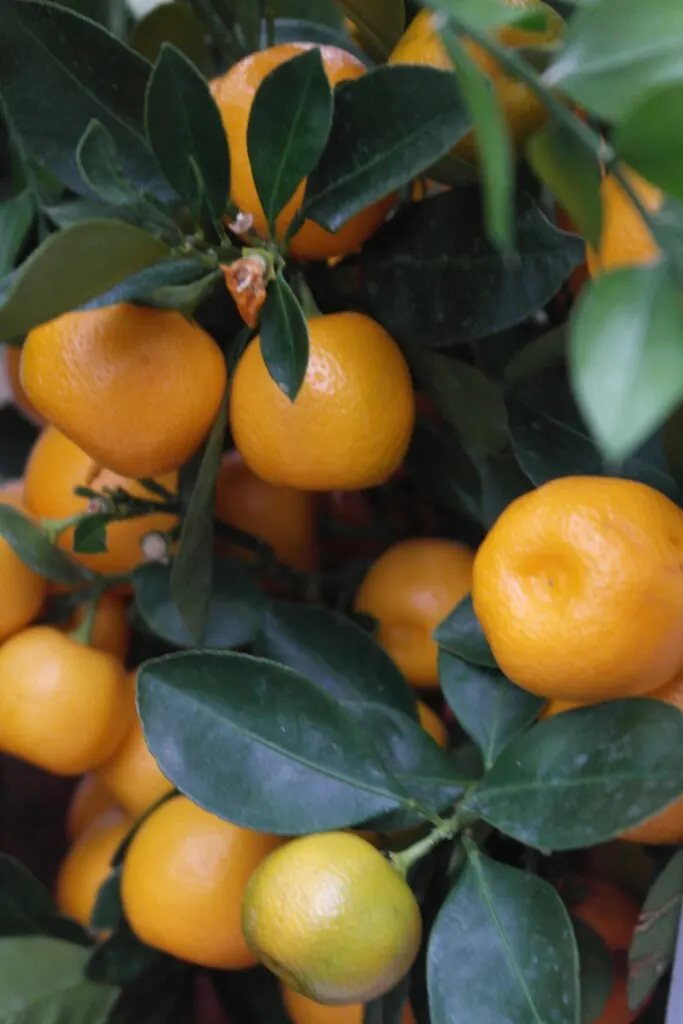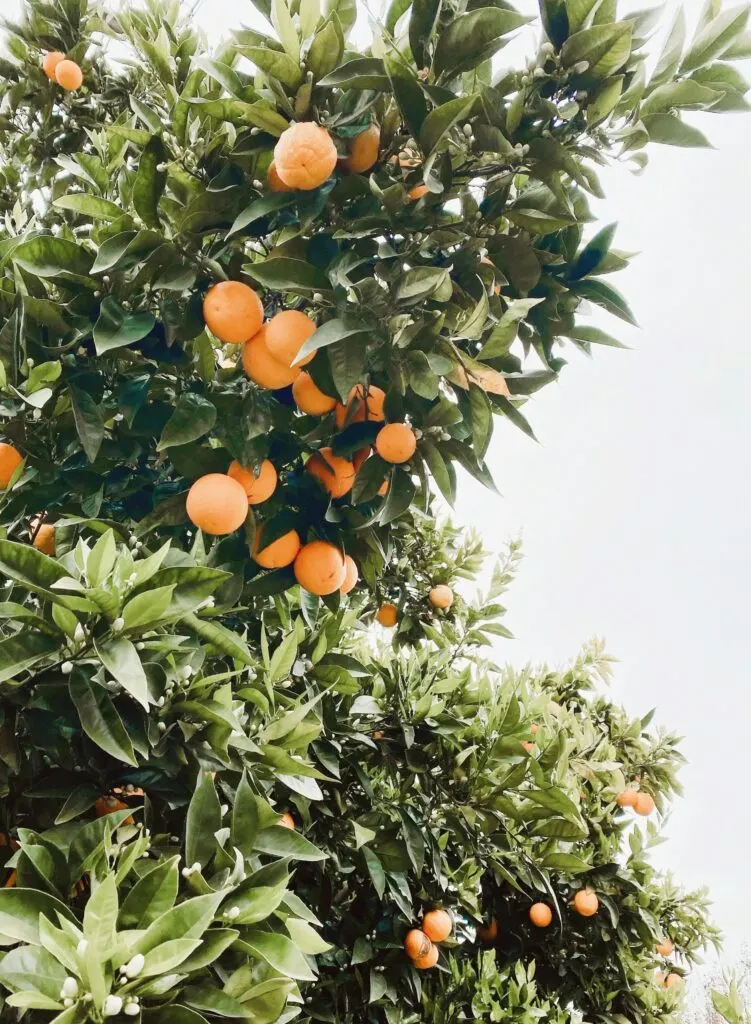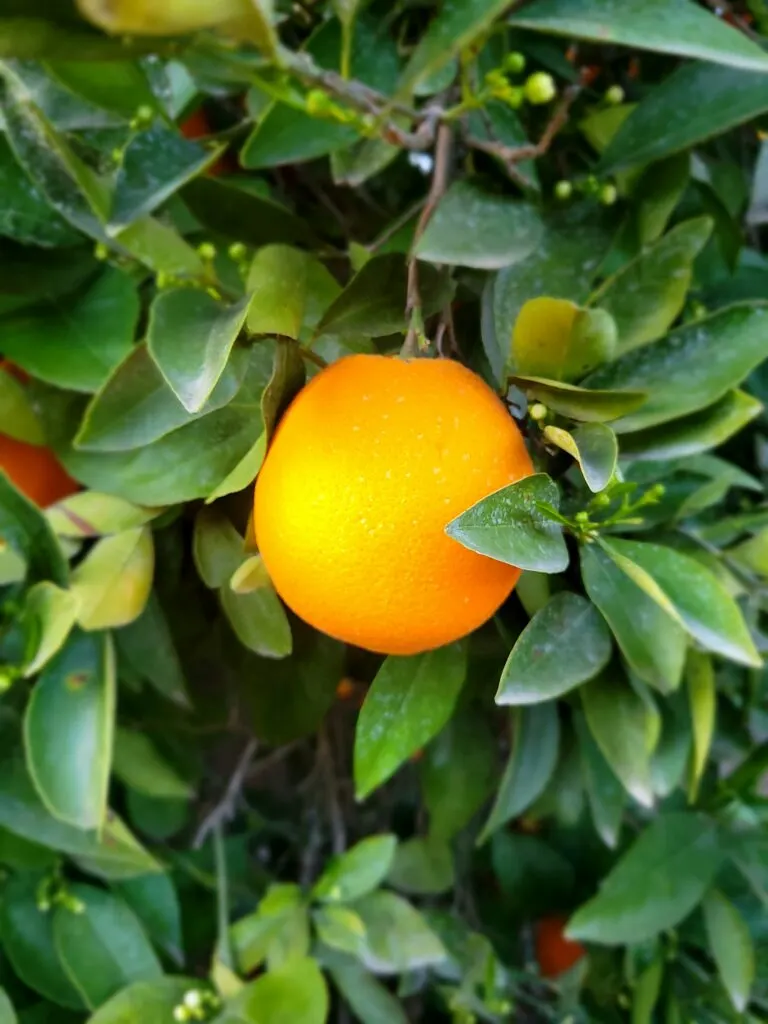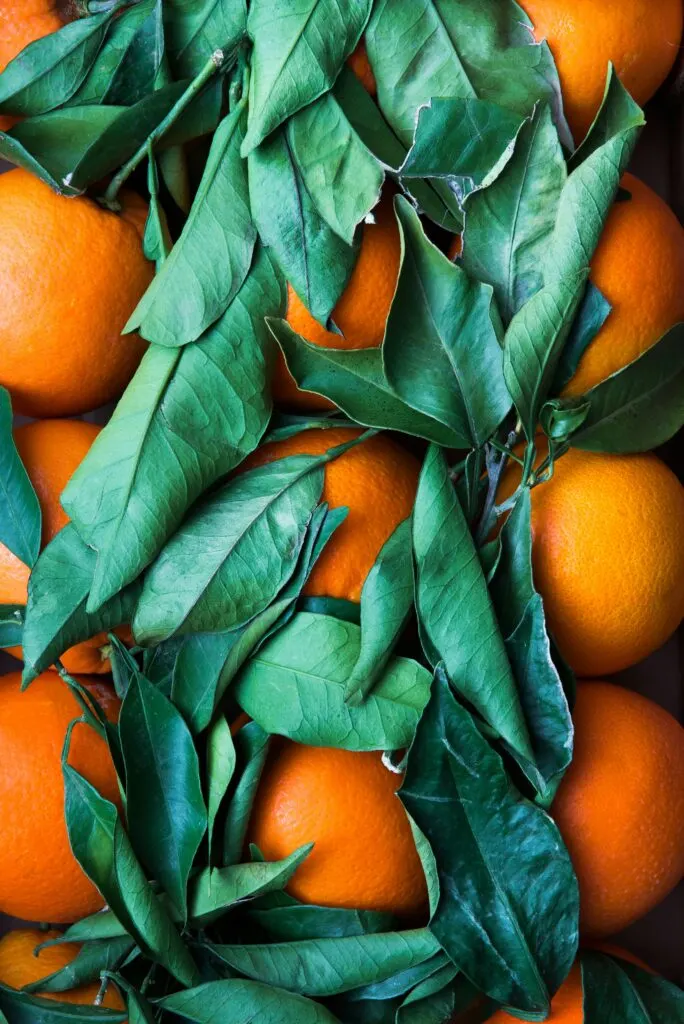Orange season in California is a vibrant time of year, offering a delicious array of citrus fruits. The peak season for oranges in California typically runs from November through June, depending on the variety. This extended period allows you to enjoy fresh, juicy oranges for much of the year.

California's diverse climate zones contribute to the state's ability to produce oranges over such a long season. From the sunny southern regions to the cooler central valleys, different orange varieties thrive in various parts of the state. You'll find navel oranges available from November to June, while Valencia oranges tend to appear later in the season.
When shopping for oranges, look for fruits that feel heavy for their size and have smooth, firm skin. This usually indicates a juicy, flavorful orange. Whether you're snacking on them fresh, using them in recipes, or squeezing them for juice, California oranges offer a burst of sunshine and vitamin C to brighten your day.
Orange Season California: A Sunny Delight for Fruit Lovers
California's Citrus History
Citrus has shaped California's agricultural landscape for centuries. You might be surprised to learn how deeply oranges are rooted in the state's history and economy.
Foundations of the Citrus Industry
Spanish missionaries introduced citrus to California in 1769. This marked the beginning of a fruitful journey for the Golden State. In 1873, a game-changing discovery occurred when a nearly seedless orange variety from Brazil made its way to the U.S. Department of Agriculture.
This new variety would soon transform California's agriculture. The Tibbets family planted the first navel orange trees in Riverside in the 1870s. These trees thrived in the California climate, producing sweet, juicy fruit.
Riverside quickly became the center of the navel orange industry. The citrus boom of the 1880s saw orchards spreading across Southern California. You can still visit one of the original trees, now over 140 years old, which stands as a living piece of California history.
Evolution of Orange Varieties
As California's citrus industry grew, so did the variety of oranges cultivated. Navel oranges, with their winter harvest, became a staple. But growers wanted to extend the season, leading to the popularity of Valencia oranges.
Valencia oranges, harvested in summer, complemented the navel orange season perfectly. This allowed for fresh orange production nearly year-round. You can enjoy California oranges in almost any season thanks to this diversification.
Blood oranges also found a home in California's orchards. These distinctive fruits, with their deep red flesh, added variety to the state's citrus palette. Today, you'll find a rich assortment of citrus fruits grown across California, each with its own unique flavor and harvest time.

Orange Varieties in California
California grows several delicious orange varieties, each with unique characteristics. You'll find a range of flavors, textures, and uses among the state's most popular oranges.
Characteristics of Navel Oranges
Navel oranges are a favorite in California. You'll recognize them by the small, undeveloped fruit that resembles a navel at the blossom end. These oranges are seedless and easy to peel, making them perfect for snacking.
Navel oranges have a sweet, slightly tart flavor and a satisfying juiciness. You'll find them harvested from November to June, with peak season in winter months.
Their thick skin protects the fruit well, so you can store navel oranges for several weeks in your refrigerator. Try them in salads, desserts, or simply enjoy them as a refreshing snack.
The Versatility of Valencia Oranges
Valencia oranges are your go-to for juicing. These thin-skinned fruits are incredibly juicy and have few seeds. You'll love their bright, tangy flavor in fresh-squeezed orange juice.
Unlike navel oranges, Valencias are harvested in summer, typically from March to July. This makes them a refreshing treat during hot California days.
Valencia oranges are versatile in the kitchen. Use them in:
- Marinades for meats
- Salad dressings
- Cocktails
- Baked goods
Their high juice content also makes them ideal for preserves and marmalades.
Exotic Appeal of Blood and Cara Cara Oranges
For something a bit different, try blood oranges or Cara Cara oranges. Blood oranges have a distinctive red flesh and a complex flavor with berry-like notes. You'll find them available from December to March.
Cara Cara oranges, a type of navel orange, have pinkish-red flesh and a lower acidity than regular navels. They're sweeter and have hints of cherry, rose, and blackberry flavors.
Both varieties add a unique twist to:
- Salads
- Sauces
- Desserts
- Cocktails
Their striking colors make them visually appealing in any dish. You'll impress your guests with these exotic California-grown oranges at your next dinner party.
Orange Season Timeline
California's orange season offers a delightful parade of citrus flavors throughout the year. You can enjoy fresh, juicy oranges from late fall through summer, thanks to the distinct harvesting periods of two main varieties.
Navel Orange Season
Navel oranges kick off the California citrus season. You'll find these sweet, seedless fruits available from November to April. The cooler winter temperatures help maintain their signature sweetness, making them perfect for snacking.
Peak harvesting occurs in January and February when navels are at their juiciest. During this time, you can often find great deals on bulk purchases at local markets.
Remember to look for firm, heavy oranges with smooth, bright skins for the best quality. Store them in your refrigerator to extend their freshness for up to two weeks.
Valencia Orange Harvesting Period
As navel season winds down, Valencia oranges take center stage. You can enjoy these juicy fruits from March to June. Valencias thrive in warmer weather, developing a perfect balance of sweetness and tang.
These oranges are ideal for juicing, so stock up during peak season in May and June. You'll get the most juice from room-temperature fruit, so let them sit out for a bit before squeezing.
Valencia oranges can last up to a month in your refrigerator, allowing you to savor that fresh-picked taste well into summer. Their versatility makes them great for both snacking and cooking.

Cultivating Oranges in California
California's unique climate and soil conditions make it an ideal place for growing oranges. Proper cultivation techniques and disease management are crucial for a successful harvest.
Growing Season Practices
You'll want to start by selecting the right orange variety for your location. Navel oranges thrive in cooler coastal areas, while Valencia oranges prefer warmer inland regions. Plant your trees in well-draining soil with plenty of sunlight.
Water your orange trees deeply but infrequently to encourage deep root growth. Oranges can be harvested at different times depending on the variety and location. Navel oranges are typically ready from November to June, while Valencia oranges are harvested from March to October.
Prune your trees annually to maintain shape and remove dead or diseased branches. This helps improve air circulation and sunlight penetration.
Apply a balanced fertilizer three times a year – in late winter, early summer, and fall. This ensures your trees have the nutrients they need throughout the growing season.
Battling Citrus Diseases
Citrus greening disease, also known as Huanglongbing (HLB), is a serious threat to California's orange industry. To protect your trees, inspect them regularly for symptoms like yellowing leaves and misshapen fruit.
Remove any infected trees immediately to prevent the disease from spreading. Use disease-resistant rootstocks when planting new trees to improve their chances of survival.
Keep your orchard clean by removing fallen leaves and fruit. This reduces the risk of fungal diseases like citrus canker and brown rot.
Apply insecticides carefully to control pests that can spread diseases. Focus on natural predators and integrated pest management techniques to minimize chemical use.
Consider installing windbreaks around your orchard to protect trees from wind-borne pathogens and reduce stress on the trees.
Health Benefits of Oranges
Oranges are not just delicious, they're also packed with nutrients that can boost your health. You'll be happy to know that these juicy fruits offer a range of benefits.
First and foremost, oranges are an excellent source of vitamin C. This essential nutrient supports your immune system and helps your body fight off infections.
Eating oranges can also contribute to better eye health. They contain vitamins and antioxidants that may help protect your vision as you age.
Did you know oranges can be good for your heart too? The fiber and potassium in these fruits support cardiovascular health.
Here are some more benefits you can enjoy:
- Improved skin health
- Better digestion
- Reduced inflammation
- Potential cancer-fighting properties
Oranges are low in calories but high in nutrients. A medium-sized orange provides:
| Nutrient | Amount |
|---|---|
| Calories | 47 |
| Fiber | 2.4g |
| Vitamin C | 90% DV |
You can easily incorporate oranges into your diet. Enjoy them as a snack, add them to salads, or squeeze them for fresh juice. Remember, whole fruits are usually better than juice as they contain more fiber.
By enjoying oranges regularly, you're giving your body a natural boost of vitamins and antioxidants. It's a simple and tasty way to support your overall health.

Harvesting and Post-Harvest Practices
Orange harvesting in California requires careful timing and proper handling to ensure the best quality fruit. You'll need to know when oranges are ripe and how to pick and store them correctly to enjoy their delicious flavor.
Techniques of Picking Ripe Oranges
To harvest your oranges, you'll want to use the right tools and methods. Hand-picking is the traditional approach, allowing you to select the ripest fruit. You'll need a sharp knife, a bucket, and a ladder for those hard-to-reach oranges.
When picking, gently grasp the orange and give it a slight twist. If it comes off easily, it's ready. Remember to harvest in the morning for the crispest, freshest fruit.
Look for these signs of ripeness:
- Full color development
- Firm, but slightly soft when squeezed
- Sweet aroma
Don't worry if your oranges have some green spots – they can still be ripe!
Storage and Transportation
After harvesting, proper storage is crucial to maintain orange quality. Keep your freshly picked oranges cool and dry. Avoid washing them immediately, as moisture can lead to mold growth.
For short-term storage:
- Place oranges in a mesh bag or open container
- Keep them in a cool spot (45-50°F is ideal)
- Check regularly for any signs of spoilage
When transporting oranges, handle them gently to prevent bruising. Use shallow containers to avoid crushing the fruit at the bottom. If you're shipping oranges, make sure they're well-packed with cushioning material.
Remember, proper post-harvest handling is key to maintaining the quality and extending the shelf life of your oranges. With these practices, you'll be able to enjoy your California oranges for weeks after harvest!
Using California Oranges in Culinary Creations
California oranges bring a burst of sunshine to your kitchen. Their versatility shines in both sweet and savory dishes, from refreshing salads to decadent desserts.
Fresh Orange Recipes and Pairings
Start your day with a zesty citrus salad. Combine orange segments with avocado, fennel, and a light vinaigrette for a refreshing breakfast or side dish. For a main course, try pairing grilled chicken with a tangy orange sauce.
Get creative with your salads by adding orange slices to mixed greens, spinach, or arugula. The sweet-tart flavor complements nuts, cheese, and vinaigrettes beautifully.
Don't forget about savory applications! Orange zest can elevate marinades for meat and fish, while fresh juice makes an excellent glaze for roasted vegetables.
Orange-based Desserts and Beverages
Quench your thirst with homemade orange juice. Simply squeeze fresh California oranges for a pure, refreshing drink. For a twist, blend the juice with strawberries or mangoes for a fruity smoothie.
In baking, oranges shine in classic desserts like orange chiffon cake or citrus tarts. Try incorporating orange zest into cookie dough or muffin batter for a subtle citrus kick.
For a show-stopping finale, create an orange-infused crème brûlée or a light and airy orange soufflé. Don't overlook candied orange peel as a delightful garnish for your sweet creations.
Companion Citrus Fruits
California's orange groves are complemented by a variety of other citrus fruits that thrive in the Golden State's climate. These zesty companions offer a range of flavors and harvesting seasons to delight your taste buds year-round.
Discovering Tangerines and Mandarins
You'll love the sweet and tangy flavor of tangerines and mandarins. These smaller citrus fruits are perfect for snacking and add a burst of flavor to your salads. Tangerines are typically available from November to January, while mandarins have a longer season from November to May.
Both fruits are easy to peel, making them ideal for on-the-go eating. Mandarins are often seedless, which adds to their convenience. You'll find that these citrus varieties are rich in vitamin C and antioxidants, supporting your immune system.
Try incorporating tangerines and mandarins into your cooking. Their juice and zest can brighten up sauces, dressings, and baked goods.
Grapefruits and Lemons in California
Grapefruits and lemons are staples in California's citrus lineup. Grapefruits offer a refreshing tartness and are harvested from November to July. You can enjoy them halved for breakfast or segmented in fruit salads.
Lemons, on the other hand, are available year-round in California. Their versatility in cooking and baking makes them a must-have in your kitchen. Use them to add zest to savory dishes or create tangy desserts.
Both fruits are packed with vitamin C and other nutrients. Grapefruits can aid in weight management, while lemons support digestion and provide a flavor boost to your water.
Citrus Cousins – Kumquats and Clementines
Don't overlook these smaller citrus varieties. Kumquats, with their edible peel, offer a unique sweet-tart experience. You can eat them whole or use them in preserves and cocktails. They're typically available from November to March.
Clementines, often called “Cuties” or “Halos,” are a hit with kids and adults alike. These seedless, easy-to-peel fruits are perfect for lunchboxes or as a quick snack. Their peak season runs from November to January.
Both kumquats and clementines are rich in antioxidants and fiber. Try adding sliced kumquats to your salads for a flavor punch, or enjoy clementines as a naturally sweet dessert option.

Marketing and Distribution of California Oranges
California's orange industry has a well-established marketing and distribution system. You'll find that the state's citrus fruits reach markets far beyond its borders.
Valencia and Navel oranges are the two main varieties distributed. Valencia oranges are typically available in summer, while Navels are a winter fruit. This allows for nearly year-round availability of fresh California oranges.
The marketing season for California oranges is quite long. You'll see Valencia oranges in markets from late spring through fall, while Navels are available from late fall through spring.
Distribution channels include:
- Supermarkets
- Farmers' markets
- Direct-to-consumer sales
- Export markets
You might be surprised to learn that California oranges are popular worldwide. The industry actively promotes its fruits in international markets, showcasing their quality and flavor.
Marketing efforts often highlight the health benefits of oranges. You'll see campaigns emphasizing their high vitamin C content and refreshing taste.
Close to 90% of California's citrus acreage is concentrated in five counties. This centralization helps streamline distribution and ensures consistent quality.
Remember, when you buy California oranges, you're supporting a vibrant local industry with a rich history and global reach.
Sustainable Practices in Orange Farming
California's orange industry is embracing sustainable practices to ensure long-term viability and environmental stewardship. You'll be pleased to know that many growers are adopting methods that protect natural resources while producing the juicy oranges you love.
Sustainable farming practices are becoming increasingly important in citrus cultivation. These techniques aim to preserve soil health, conserve water, and reduce chemical inputs. As a result, you can enjoy your California oranges knowing they're grown with care for the environment.
Water conservation is a top priority in orange farming. Growers are implementing efficient irrigation systems like drip irrigation and moisture sensors. These tools help you use water wisely, ensuring every drop counts in nurturing those delicious oranges.
Integrated Pest Management (IPM) is another key practice. Instead of relying solely on pesticides, farmers use natural predators and traps to control pests. This approach helps keep your oranges free from harmful chemicals while maintaining ecosystem balance.
Soil health is crucial for sustainable orange production. You'll find many growers using cover crops and composting to enrich the soil naturally. These methods improve soil structure and fertility without relying on synthetic fertilizers.
Organic citrus farming is gaining popularity too. Some growers are transitioning to organic practices, avoiding synthetic pesticides and fertilizers altogether. This shift allows you to enjoy oranges that are both environmentally friendly and free from artificial additives.
By supporting sustainable orange farming, you're not just getting tasty fruit – you're also contributing to the long-term health of California's citrus industry and environment.
Community and Cultural Impact
Orange season in California brings more than just delicious fruit to your table. It fosters a sense of community and cultural richness across the state.
You'll find local farmers' markets bustling with activity as vendors proudly display their vibrant citrus harvests. These markets become social hubs, where you can connect with neighbors and learn about the rich history of California's citrus industry.
Orange-themed festivals pop up in many towns, celebrating the fruit's importance. You might enjoy:
- Orange peeling contests
- Citrus-inspired art exhibitions
- Live music and dance performances
These events strengthen community bonds and create lasting memories for you and your family.
The citrus industry has deeply influenced California's cultural landscape. You can explore this heritage through:
- Museum exhibits showcasing vintage orange crate labels
- Historical tours of old packing houses
- Cooking classes featuring creative orange-based recipes
By participating in these activities, you're not just enjoying the fruit but also preserving and celebrating local culture.
Remember, when you buy California oranges, you're supporting local farmers and contributing to the state's agricultural legacy. It's a tasty way to be part of something bigger!

Stacy Molter is the visionary behind California Unpublished, a vibrant blog that showcases the dynamic California lifestyle by delving into its rich culinary offerings and stunning destinations. California Unpublished is your go-to guide for transforming everyday life into something extraordinary! As a family of passionate travelers, we are committed to discovering the finest experiences California has to offer and sharing our adventures as we fully embrace life.
So, take a seat, pour yourself a refreshing drink, and come along with us on our exciting journey through the Golden State!
